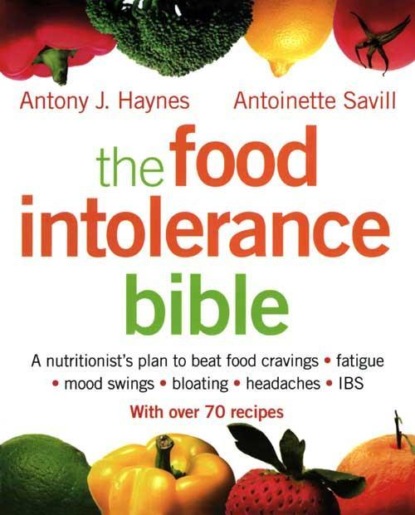По всем вопросам обращайтесь на: info@litportal.ru
(©) 2003-2025.
✖
The Food Intolerance Bible: A nutritionist's plan to beat food cravings, fatigue, mood swings, bloating, headaches and IBS
Автор
Год написания книги
2019
Настройки чтения
Размер шрифта
Высота строк
Поля
irritability
lack of motivation/get up and go
migraines (2)
mood swings
palpitations
panic attacks
phobias
poor concentration
racing pulse
restless legs syndrome
slurred speech
spaciness (2)
tenseness
tinnitus (ringing in the ears) (2)
uncharacteristic inability to make decisions
(18 x 2 = 36)
(21 x 1 = 21)
Sub-total/maximum = /57
SECTION THREE – OVERT PHYSICAL SIGNS AND SYMPTOMS
abnormal physical weakness or tiredness
aching muscles and joints for no good reason (2)
arthritis
asthma
chronic infections
eczema
fibromyalgia (diagnosed by a physical therapist or doctor) (2)
hives (urticaria) (2)
itching (2)
painful joints in which the pain moves from one joint to another (2)
painful joints not associated with excessive use (2)
psoriasis (2)
rheumatoid arthritis
rough, dry skin
spots or acne (that are not hormonally related)
skin rashes (for no other known reason) (2)
wheezing
(8 x 2 = 16)
(9 x 1 = 9)
Sub-total/maximum = /25
WHAT IS YOUR SCORE?
INTERPRETING YOUR SCORE
Essentially, the higher your score, the more likely it is that your reactions are the result of a food intolerance. (The individual section scores are important in themselves, since, for example, they may highlight digestive problems that are distinct from food intolerances – more about this later.)
Note: Do not reintroduce a food if you suffer with a severe physical reaction such as wheezing or asthma, without medical supervision.
If Your Score Is Between 0 and 15
This is a low score and not particularly indicative of food intolerance. Please check your diet to see if it contains many of the ‘Usual Suspects’ and avoid two of the most frequently-eaten foods, replacing them with alternatives. Avoid these foods for two weeks and observe whether your symptoms improve. If your symptoms have improved, then avoid these foods for a further two weeks (one month in total). Then reintroduce the foods, one at a time, allowing four days in between. Eat a normal portion of the food. Observe whether any of your symptoms return. Sometimes foods continue to trigger reactions even after you have avoided them for a period of time, sometimes not. However, even if there is no worsening of symptoms, it is suggested that you do not eat the culprit food(s) every day, in case you re-create the original intolerance symptoms. If a food triggers symptoms again, then avoid the food completely for two months and repeat the reintroduction process. If the symptoms persist after this time, continue to avoid the food, but investigate other conditions detailed in later chapters of this book. This will be helped by completing the relevant questionnaires.
If, after the two weeks, your symptoms have not improved by avoiding the two main potential culprits, then reintroduce them in the manner described. Sometimes this can still trigger other symptoms – or worsen the ones you already have – which highlights that the specific food is a culprit food and needs to be avoided for a month. However, because your overall symptoms have not improved, this indicates that other intolerances, or even other conditions, may exist. If this is the case, you are recommended to follow the next paragraph’s instructions AND complete the questionnaires in the chapters that follow, to help identify any other conditions you may be suffering from.
Since your score is so low, there is no strong indication for you to undertake a food-intolerance test at this stage.
If Your Score Is Between 16 and 25
This is a moderate score and reflects that you have too many symptoms to be in optimal health. You need to do something different in order to improve your symptoms, and a food intolerance investigation should be carried out as part of this process. Please check your diet to see if it contains many of the ‘Usual Suspects’ and avoid the top four of these (in terms of regularity and volume of consumption – e.g. wheat, dairy, sugar and tomatoes – or whatever you identify in your diet), for two weeks.
Also, start the Digestive Support Plan, as detailed in Part 3.







